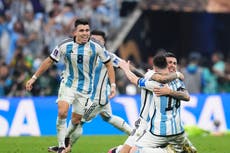Argentina vs France: How the chaos of the greatest ever World Cup final unfolded
Argentina 3-3 France (4-2 on pens): Lionel Messi finishes with his World Cup, in a story written by so many more
It’s Lionel Messi’s day, it’s Lionel Messi’s World Cup, but for more than a moment it looked to have been Kylian Mbappe’s. There is no debate that the Lusail Stadium has staged the greatest World Cup final in history and while the outcome was determined and decided by its biggest names it was a match where its momentum and very spirit was shaken and influenced by so much more.
The illusion is thinking there was order to the chaos. At first it was Angel Di Maria and a masterstroke from Lionel Scaloni. And then it was Randal Kolo Muani and Marcus Thuram, thrown on out of desperation by Didier Deschamps. Argentina had been inspired but France responded. Then, when France had control of the World Cup and sensed history, Argentina found Emiliano Martinez and, from nowhere, Gonzalo Montiel.
This is Argentina’s World Cup, but this was a final that belongs to those who wrote its drama. France did not have a plan to stop Argentina and Messi. It is not the role of the defending champions to bend the knee, after all, but with five minutes to go in the first half of the World Cup final France were two goals down and Deschamps had no other option but to try something new.
Until then, France had offered nothing. While Argentina changed their approach for the final, with Di Maria recalled to pull France out of shape until they fell apart, Deschamps believed his starting hand was stronger. How Argentina would shut down Mbappe and France’s left side was thought to be one of the areas that would define the World Cup final. Instead, Scaloni had flipped the question and sent Deschamps scrambling for an answer.
Deschamps produced one in a moment of World Cup history, becoming the first manager to make a double substitution before half time in a final. Ousmane Dembele, tortured by Di Maria’s positioning in the early exchanges, was hooked alongside Olivier Giroud. Kolo Muani and Thuram were the substitutions that changed everything, even if their impact was not immediate.
Rather, what was almost the most astonishing comeback in World Cup final history was made both by the sudden emergence of Mbappe and the gradual turning of the tide Deschamps and his substitutions produced.
Argentina had started by finding their own answers. Scaloni had looked to have produced one of the great tactical tweaks in World Cup final history, as Di Maria danced in the blind spot France left behind.

The allure of Messi finally winning the World Cup will be the story that obscures everything else from this final, but it should not be forgotten how Argentina’s victory was also pieced together from the tireless work and sacrifices by his team-mates. Throughout the World Cup, Argentina have grown in strength as Messi’s disciples fueled a system that allows Messi to produce the moments only he can.
Di Maria is perhaps the second star of this Argentina team, the scorer of their winning goal against Brazil in last summer’s Copa America final. He had only played nine minutes of the knockout stages due to injury and in his absence Argentina managed to become even more selfless in their application. Without him, Argentina had also shown flexibility. Against the Netherlands and Croatia, Scaloni had tinkered his system not only to get the best out of Argentina, but with the strengths and weaknesses of their opponents in mind.
The twist from Argentina was not just the inclusion of Di Maria, but where he was positioned. That his latest decisive contributions in a major final came from the left and not the right was Scaloni’s trick card. Di Maria did not just start on the opposite flank to where he has made a career out of cutting inside from, he did so by pulling the definition of width to its extremity. In doing so, he tipped the balance of Argentina’s attack.

That it came by design was a vindication of Argentina and Scaloni’s approach, until France turned it around. Kolo Mauni and Thuram offered an injection of energy and directness on the wings, helping to blunt Di Maria’s threat. Antoine Griezmann had perhaps been France’s best player in Qatar but was sacrificed for Kingsley Coman, who took inspiration by turning in a sublime display as an ersatz centre midfielder.
Eduardo Camavinga found himself at left back and from there France found their feet in the spaces that had previously been dominated by Rodrigo De Paul. Before then, De Paul was able to tie Argentina’s plans all together, allowing Di Maria to stay high and wide on the left. He matched Adrien Rabiot to maintain Argentina’s numerical balance in midfield. He pulled wide to track Theo Hernandez’s adventurous runs on the outside - which if the World Cup final had played out differently might have been the equivalent of Di Maria’s positioning. De Paul also tucked inside to track Mbappe, on the occasions in which Nahuel Molina restored the shape by going wider.
Mbappe could not be stopped, nor could this final from reaching the most remarkable of conclusions. Scaloni turned to Lautaro Martinez and France became stretched, for the first time since Di Maria was unable to continue. It finishes, though, with Messi and with his World Cup, in a story written by so many more.
Join our commenting forum
Join thought-provoking conversations, follow other Independent readers and see their replies
Comments


Bookmark popover
Removed from bookmarks